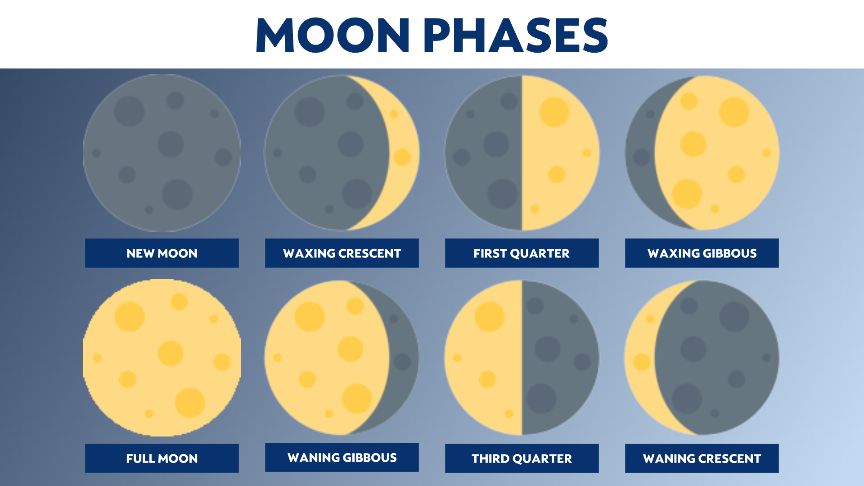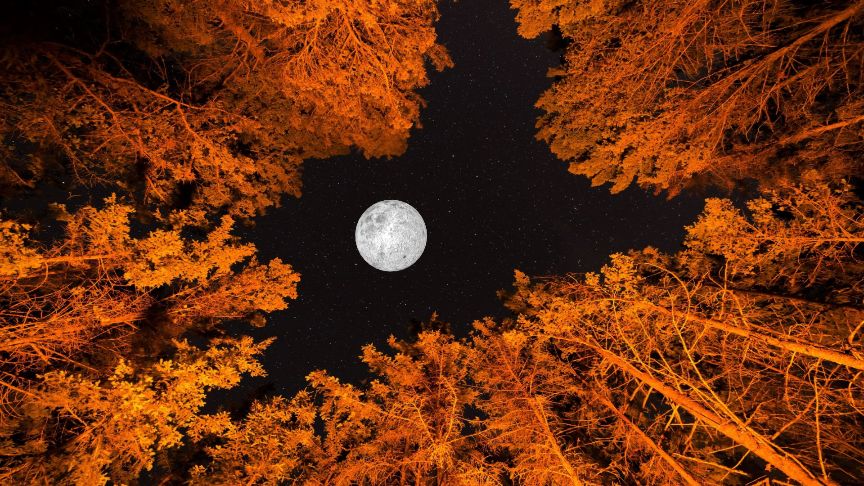Have you ever looked up into the night sky and wondered why the moon always looks different? Learn the science behind the moon phases and how to identify them.
I know we're focusing on the moon in this blog, but the sun plays a role. Get this. The sun always illuminates half of the moon. So if this is the case, why doesn't the moon always appear full?
Because the moon orbits around the Earth, it will appear more or less illuminated depending on its position.

Once you know what the different phases look like, it'll be easier for you to identify them in the sky.
The one thing that will help you is remembering the title of this blog. When the moon is "waxing," it will appear more illuminated, and when it is "waning," less of it will illuminate night by night.
New Moon: The full moon and this phase are the two easiest phases to identify. With the new moon, it will look as if the moon is missing entirely from the sky. That's because, at this point, the sun illuminates the back of the moon not facing the Earth.
Waxing Crescent: Things get a little bit trickier when differentiating between waxing and waning. For these "in-between" phases, it helps to monitor the progression of the moon's lit surface each night. Then you can tell if it's becoming more or less illuminated. Regardless, in this phase, only a sliver of the moon is apparent.
First Quarter: This one always gets me. In this phase, the moon appears to be half-lit. So, you're probably thinking, 'why is this not called the half moon?' Remember, you're only seeing half of the moon at any time because the other half is facing the sun. Therefore, when you take half of half, you get a quarter!
Waxing Gibbous: Most of the moon is illuminated in this phase, and more of it shows each night leading up to the full moon.
Full Moon: This will be the complete opposite of the new moon. Instead, the sun will illuminate the front half of the moon facing the Earth.
Waning Gibbous: Here, we start going backward, and each night, less and less of the moon will appear. At this phase, the moon appears to us three-fourths lit.
Third Quarter: Like the first quarter, although it appears half-lit, it is half of the half you can see (thus making it a quarter).
Waning Crescent: One little crescent is left illuminated before eventually returning to its "invisible" phase, otherwise known as the new moon.

Did you know each full moon has a nickname? Throughout time, groups would designate a name to a full moon based on what was going on around them during that time.
Although there is typically about one full moon per month, some calendar years may allow for 13.
- January - Wolf Moon: This was named after the wolves howling for hunger due to the lack of food in winter.
- February - Snow Moon: Since it often snows during this month, the full moon name fits.
- March - Worm Moon: This one sounds weird but makes sense. In March, the ground starts to thaw, gearing up for spring. And in spring, worms start to appear.
- April - Pink Moon: This one was always my favorite name growing up because my favorite color is pink. Unfortunately, that's not the reason for the name. Instead, this full moon was named after the color of an early-blooming wildflower.
- May - Flower Moon: As the saying goes, April showers bring May flowers. So, to that end, the reason for the flower moon!
- June - Strawberry Moon: Now the song "Strawberry Fields Forever" is stuck in my head. Anyway, this is the time in North America when we harvest strawberries.
- July - Buck Moon: This is the time of year when male deer regrow their antlers. (And no, it wasn't named after the Milwaukee Bucks winning the 2021 NBA Championship...)
- August - Sturgeon Moon: I'm sure the folks in Sturgeon Bay love the name of this moon. This name originated from North American fishing tribes seeing an abundance of this specific species during August.
- September - Harvest Moon (or Corn Moon): This full moon is bright, allowing farmers to harvest their crop for a longer period.
- October - Hunter's Moon: I know a lot of hunters are excited for this one. Since the moon is especially bright, it allows hunting into the nighttime.
- November - Beaver Moon: We're in a little bit of a predicament as to the reason behind this name. All you need to know is the name was associated with either Native Americans setting up beaver traps or beavers building their winter dams. You could also refer to it as the "Frost Moon." As a meteorologist, I think that one is more fitting.
- December - Cold Moon: Finally, and maybe the most obvious name of them all, is the December full moon because it is cold during this month.
- Bonus - Blue Moon: We have a bonus full moon! This happens when we get 13 instead of 12 full moons in a year. Since our calendar doesn't perfectly line up with the lunar calendar, there are 11 days left over. About every two or three years, the leftover days add up, allowing for two full moons in a month: a Blue Moon.



